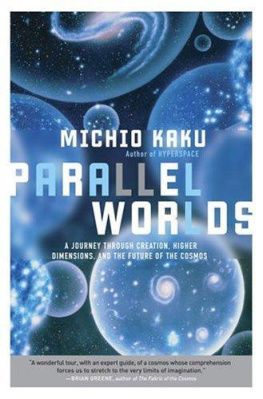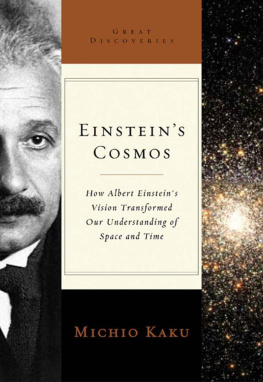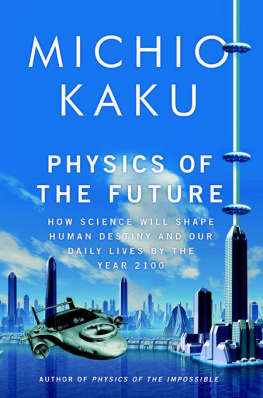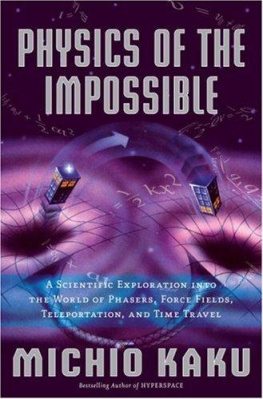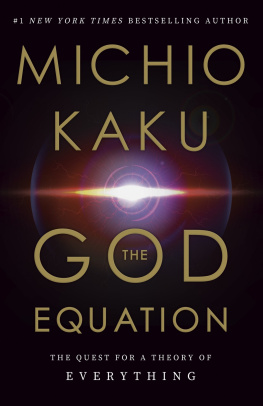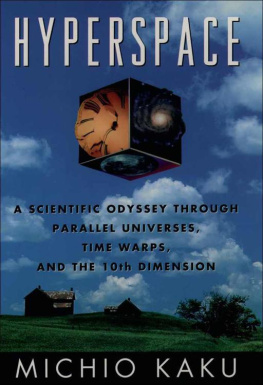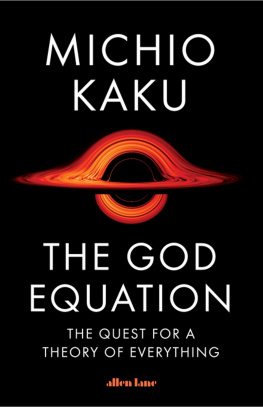PARALLL WORLDS
AJourney Through Creation, Higher Dimensions, andthe Future of the Cosmos
CONTENTS
chapter three: The Big Bang
chapter eight: A Designer Universe?
chapterten: The End of Everything
PREFACE
Cosmology is thestudy of the universe as a whole, including its birth and perhaps its ultimatefate. Not surprisingly, it has undergone many transformations in its slow,painful evolution, an evolution often overshadowed by religious dogma andsuperstition.
The first revolution in cosmology was ushered in by the introductionof the telescope in the 1600s. With the aid of the telescope, Galileo Galilei,building on the work of the great astronomers Nicolaus Copernicus and JohannesKepler, was able to open up the splendor of the heavens for the first time toserious scientific investigation. The advancement of this first stage ofcosmology culminated in the work of Isaac Newton, who finally laid down thefundamental laws governing the motion of the celestial bodies. Instead of magicand mysticism, the laws of heavenly bodies were now seen to be subject toforces that were computable and reproducible.
A secondrevolution in cosmology was initiated by the introduction of the greattelescopes of the twentieth century, such as the one at Mount Wilson with itshuge 100-inch reflecting mirror. In the 1920s, astronomer Edwin Hubble usedthis giant telescope to overturn centuries of dogma, which stated that theuniverse was static and eternal, by demonstrating that the galaxies in theheavens are moving away from the earth at tremendous velocitiesthat is, theuniverse is expanding. This confirmed the results of Einstein's theory ofgeneral relativity, in which the architecture of space-time, instead of beingflat and linear, is dynamic and curved. This gave the first plausibleexplanation of the origin of the universe, that the universe began with acataclysmic explosion called the "big bang," which sent the stars andgalaxies hurtling outward in space. With the pioneering work of George Gamowand his colleagues on the big bang theory and Fred Hoyle on the origin of theelements, a scaffolding was emerging giving the broad outlines of theevolution of the universe.
A thirdrevolution is now under way. It is only about five years old. It has beenushered in by a battery of new, high-tech instruments, such as spacesatellites, lasers, gravity wave detectors, X-ray telescopes, and high-speedsupercomputers. We now have the most authoritative data yet on the nature ofthe universe, including its age, its composition, and perhaps even its futureand eventual death.
Astronomers nowrealize that the universe is expanding in a runaway mode, accelerating withoutlimit, becoming colder and colder with time. If this continues, we face theprospect of the "big freeze," when the universe is plunged intodarkness and cold, and all intelligent life dies out.
This book isabout this third great revolution. It differs from my earlier books on physics, Beyond Einstein and Hyperspace, which helped to introduce to the public the new concepts ofhigher dimensions and superstring theory. In Parallel Worlds, instead of focusing on space-time, I concentrate on therevolutionary developments in cosmology unfolding within the last severalyears, based on new evidence from the world's laboratories and the outermostreaches of space, and new breakthroughs in theoretical physics. It is my intentionthat it can be read and grasped without any previous introduction to physicsor cosmology.
In part 1 of thebook, I focus on the study of the universe, summarizing the advances made inthe early stages of cosmology, culminating in the theory called"inflation," which gives us the most advanced formulation to date ofthe big bang theory. In part 2, I focus specifically on the emerging theory ofthe multiversea world made up of multiple universes, of which ours is butoneand discuss the possibility of wormholes, space and time warps, and howhigher dimensions might connect them. Superstring theory and M-theory havegiven us the first major step beyond Einstein's original theory; they givefurther evidence that our universe may be but one of many. Finally, in part 3,I discuss the big freeze and what scientists now see as the end of ouruniverse. I also give a serious, though speculative, discussion of how anadvanced civilization in the distant future might use the laws of physics toleave our universe trillions of years from now and enter another, morehospitable universe to begin the process of rebirth, or to go back in time whenthe universe was warmer.
With the floodof new data we are receiving today, with new tools such as space satelliteswhich can scan the heavens, with new gravity wave detectors, and with newcity-size atom smashers nearing completion, physicists feel that we are enteringwhat may be the golden age of cosmology. It is, in short, a great time to be aphysicist and a voyager on this quest to understand our origins and the fate ofthe universe.
P A R T O N E
THE UNIVERSE
CHAPTER ONE
Baby Picturesof the Universe
The poet onlyasks to get his head into the heavens. It is the logician who seeks to get theheavens into his head. And it is his head that splits. G. K. Chesterson
When i was a child, I had apersonal conflict over my beliefs. My parents were raised in the Buddhisttradition. But I attended Sunday school every week, where I loved hearing thebiblical stories about whales, arks, pillars of salt, ribs, and apples. I wasfascinated by these Old Testament parables, which were my favorite part ofSunday school. It seemed to me that the parables about great floods, burningbushes, and parting waters were so much more exciting than Buddhist chantingand meditation. In fact, these ancient tales of heroism and tragedy vividlyillustrated deep moral and ethical lessons which have stayed with me all mylife.
One day inSunday school we studied Genesis. To read about God thundering from theheavens, "Let there be Light!" sounded so much more dramatic thansilently meditating about Nirvana. Out of naive curiosity, I asked my Sundayschool teacher, "Did God have a mother?" She usually had a snappyanswer, as well as a deep moral lesson to offer. This time, however, she wastaken aback. No, she replied hesitantly, God probably did not have a mother."But then where did God come from?" I asked. She mumbled that shewould have to consult with the minister about that question.
I didn't realizethat I had accidentally stumbled on one of the great questions of theology. Iwas puzzled, because in Buddhism, there is no God at all, but a timelessuniverse with no beginning or end. Later, when I began to study the greatmythologies of the world, I learned that there were two types of cosmologies inreligion, the first based on a single moment when God created the universe, thesecond based on the idea that the universe always was and always will be.
They couldn'tboth be right, I thought.
Later, I beganto find that these common themes cut across many other cultures. In Chinesemythology, for example, in the beginning there was the cosmic egg. The infantgod P'an Ku resided for almost an eternity inside the egg, which floated on aformless sea of Chaos. When it finally hatched, P'an Ku grew enormously, overten feet per day, so the top half of the eggshell became the sky and the bottomhalf the earth. After 18,000 years, he died to give birth to our world: hisblood became the rivers, his eyes the sun and moon, and his voice the thunder.
In many ways,the P'an Ku myth mirrors a theme found in many other religions and ancientmythologies, that the universe sprang into existence creatio ex nihilo (created from nothing). In Greekmythology, the universe started off in a state of Chaos (in fact, the word"chaos" comes from the Greek word meaning "abyss"). Thisfeatureless void is often described as an ocean, as in Babylonian and Japanesemythology. This theme is found in ancient Egyptian mythology, where the sun godRa emerged from a floating egg. In Polynesian mythology, the cosmic egg isreplaced by a coconut shell. The Mayans believed in a variation of this story,in which the universe is born but eventually dies after five thousand years,only to be resurrected again and again to repeat the unending cycle of birthand destruction.
Next page
